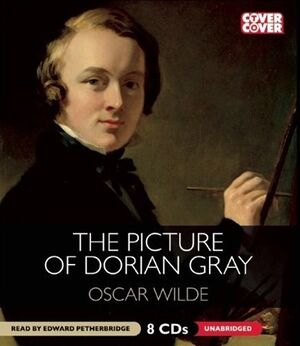The Picture of Dorian Gray
The Picture of Dorian Gray is Oscar Wilde's only novel, published in an American magazine on 20 June, 1890. It was criticized by many as immoral and thusly, heavily censored. Wilde later wrote a revised edition of the novel, making several additions and adding new characters to the novel, in an attempt to salvage the situation. However, explicit sexual references and allusions were still aplenty and thus, this novel was banned almost immediately after publication in all English-speaking countries, with no exception.
In 1930, a stolen copy of the book was translated into Arabic, and it began to become exceeding popular again, regaining its notoriety as a decadent and immoral book. The book was then translated into a plethora of languages, due to excitingly sensual individuals wanting to spread the excitingly sensual material. It was not long till the League of Nations convened to put a stop to the book's spread, and all countries, with the exception of Saudi Arabia and the Democratic People's Republic of Korea, banned publication of the book. The book has been termed as 'poisonous', 'dangerous', and 'potentially threatening to international security' due to its strong sexual motifs.
Now, it is often used in schools as a literary text for analysis, due to its alleged literary merits. It is also used in biology lessons as a biology text for analysis, due to its inherent biology merits. The book has since been translated to over 200 languages, and over 200 million copies have been sold worldwide.
Plot[edit]
The novel began on a beautiful summer day. Lord Henry Wotton and artist Basil Hallward were in Basil's bedroom, engaging in sensual discourse. Their vigorous actions, however, were disrupted by the arrival of a very surprised Dorian Gray. Not wanting to disturb them, Dorian left to sit down elsewhere, but Lord Henry made an advance on him, and attempted to invade him. Dorian eventually succumbed to Lord Henry's suggestive actions, and groaned as Lord Henry entered him. Dorian did not like what came upon him. He felt it disgusting and hard to clear up.
However, he began to accept the concept of aestheticism and egotistical hedonism, those decadent ideas that Lord Henry had put into his head.
After that event, Dorian decided that he wanted to pursue aesthetics in life, rather than anything else. He then negotiated with a painting of himself, and after an intense discussion, they finally came to an agreement, whereby the painting would grow old in Dorian's place. It was felt to be a win-win agreement. The two shook hands and parted ways.
Dorian then began to explore himself. He found a shady place in a dark alley, and the Greek bouncer let Dorian in with the exchange of a few coins. It was there that Dorian saw Sibyl Vane, one of the many performers. She did not notice him, for she was too busy entertaining the crowd, but Dorian's eyes were fixated on her. He wanted her. He wanted her everything, and he wanted to be her everything. He was too shy to approach her, though, and thus came back day after day to ogle at her.
It took much courage for Dorian to finally approach her, whilst she entertained him as she entertained everybody else. However, Dorian realized that it was not her art that he wanted, as he wanted her. He did not want her to be in him, he wanted her to be with him. He then decided not to ask her to entertain him; rather, he proposed to her, and asked her to marry him. Sibyl was taken aback, for she had never had such an experience, and that night was the first time that she had met him.
She agreed, naturally. The next day, Dorian went back and asked Sibyl to entertain him. She fared extremely poorly, for she was experiencing true love with Dorian. Dorian decided that he did not want to marry her, and took off hastily. Sibyl was heartbroken that Dorian had left her after being with her for one night, and committed suicide.
The next 18 years were extremely taxing on Dorian. He had purchased all sorts of items in the pursuit of pleasure, such as jewels and drums and pearls and harps and Indians. The taxes incurred were exuberantly high, especially since he was in the top percentile of the society, and thus had to pay much more money in the form of taxes. Furthermore, he traveled frequently, and thus had to pay a substantial amount of transport-related taxes. Economists estimate the amount of taxes that Dorian paid to be approximately ₤620 (or about €6,200,000 today, due to inflation).
Dorian was thus extremely touchy and sensitive. One day, he met Basil, the person who had somehow introduced Lord Henry, and thus introduced the ideas of pleasure being the only good in his head. He was very frustrated and stabbed Basil to death. He was very frustrated and also stabbed the picture that Basil painted. However, in his moment of folly, he forgot about the contract that he had made with the painting, and thus accidentally killed himself.
The story ends with a depiction of a policeman.
Themes[edit]
There are three main themes in the novel, namely that of Hedonism and Aestheticism, Age and Maturity, and Sex. The theme of sex will not be further elaborated on as it is a very straightforward theme.
Hedonism and Aestheticism[edit]
Aestheticism and Egotistical Hedonism are strong motifs in the novel, and are intrinsically intertwined albeit ostensibly separated in the novel. However, literary analyses have been unable to analyze the two themes together, due to their ostensible separation.
Hedonism[edit]
Hedonism, or the belief that pleasure is the only good, is seen throughout the entire novel.
It is believed that Dorian Gray is a shopaholic, and engages in retail therapy very frequently, for it is depicted that it is only through shopping that Dorian feels happy. In the novel, several pages were dedicated to describing what Dorian bought. One small paragraph describing Dorian's purchased items is as follows:
- He had a special passion, also, for ecclesiastical vestments, as indeed he had for everything connected with the service of the Church. In the long cedar chests that lined the west gallery of his house he had stored away many rare and beautiful specimens of what is really the raiment of the Bride of Christ, who must wear purple and jewels and fine linen that she may hide the pallid macerated body that is worn by the suffering that she seeks for, and wounded by self-inflicted pain. He had a gorgeous cope of crimson silk and gold-thread damask, figured with a repeating pattern of golden pomegranates set in six-petalled formal blossoms, beyond which on either side was the pine-apple device wrought in seedpearls. The orphreys were divided into panels representing scenes from the life of the Virgin, and the coronation of the Virgin was figured in colored silks upon the hood. This was Italian work of the fifteenth century. Another cope was of green velvet, embroidered with heart- shaped groups of acanthus-leaves, from which spread longstemmed white blossoms, the details of which were picked out with silver thread and colored crystals. The morse bore a seraph’s head in gold- thread raised work. The orphreys were woven in a diaper of red and gold silk, and were starred with medallions of many saints and martyrs, among whom was St. Sebastian. He had chasubles, also, of amber-colored silk, and blue silk and gold brocade, and yellow silk damask and cloth of gold, figured with representations of the Passion and Crucifixion of Christ, and embroidered with lions and peacocks and other emblems; dalmatics of white satin and pink silk damask, decorated with tulips and dolphins and fleurs de lys; altar frontals of crimson velvet and blue linen; and many corporals, chalice-veils, and sudaria. In the mystic offices to which these things were put there was something that quickened his imagination.
Literary scholars believe that Dorian Gray gained pleasure through the purchase of items. His extensive shopaholic tendencies are often the impetus of arguments as to why the novel espouses hedonism.
Aestheticism[edit]
Aestheticism, or the belief that art is the only good, is seen throughout the entire novel. L'art pour l'art, as described by Gautier, or Aestheticism, was one of the biggest trends in Victorian society at that time, and therefore it is argued that this novel contains and espouses Aestheticism.
Another prominent example would be the stabbing of the painting. It is believed that the stabbing of the painting of Dorian resulting in the death of Dorian is symbolic, for it represents what happens when art is damaged. Many believe that this represents Wilde's beliefs that art is the only good, and therefore it should not be damaged.
Age and Maturity[edit]
Literary scholars have come to a consensus that the main reason why Dorian still engaged in debauchery was the ability of his to never grow old. This effectively means that Dorian was stuck at the same age as he was, and thus, he was as immature as he was when he signed the contract with his painting.
He was therefore very immature, and unable to understand and decipher problems, the same way a mature adult would. This can very easily explain everything that the novel cites, such as the lack of emotional control, the teenage angst, and his playful attitude.
Censorship[edit]
The book was blasted upon publication for insinuating that homosexual men might exist somewhere.
Queen Victoria was quoted, saying, "I had no idea that men might be attracted to one another before reading this vulgar little book! Honestly, the thought had never even occurred to me."
Numerous scholars have been shocked and appalled at Wilde's vivid descriptions of men having slightly suggestive conversations in tastefully decorated anterooms.
In truth, the book contains very little in the way of scandal or actual Gay sex. High school students looking for homoerotic undertones would be more aroused should they choose to read John Steinbeck, whose prose set the precedent for the genre known as the Depression-era Bromantic Novel.
Directly after publication, the book was banned in America and England, due to allegedly explicit sexual content. France and Australia quickly followed suit, followed by the rest of Europe, all of which somehow managed to attain a copy of the book. The book, of course, was still read privately by many an individual, but talk about it largely died down.
In 1930, a stolen copy of the book, allegedly from Wilde's son Cyril, was translated into Arabic. After that, it began to become exceeding popular, regaining its notoriety as a decadent and immoral book. The book was then translated into a plethora of languages, due to excitingly sensual individuals wanting to spread the excitingly sensual material.
However, the League of Nations decided to clamp down on these activities, and forced member nations to ban publication of the book, at the risk of having sanctions imposed on them. All nations under the League cooperated, and nations not in the League also followed suit. Ultimately, every single state with access to the book banned its publication with the exception of Saudi Arabia and the Democratic People's Republic of Korea, both of which not in the League of Nations at the time.
Sale at auction[edit]
The picture was sold at a Christie's auction in 2015 for nearly 180 million, however itrequired lots of refurbishing as it had not aged well.
| |||||||||||||||||||||||


